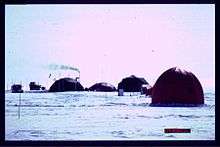Greenland ice core project

The Greenland Ice Core Project (GRIP) was a multinational European research project, organized through the European Science Foundation.[1] Funding came from 8 nations (Belgium, Denmark, France, Germany, Iceland, Italy, Switzerland, and United Kingdom), and from the European Union.
The project ran from 1989 to 1995, with drilling seasons from 1990 to 1992.[2] GRIP successfully drilled a 3029-metre ice core to the bed of the Greenland ice sheet at Summit, Central Greenland from 1989 to 1992 at 72°34.74′N 37°33.92′W / 72.57900°N 37.56533°W.[3]

Studies of isotopes and various atmospheric constituents in the core have revealed a detailed record of climatic variations reaching more than 100,000 years back in time. The results indicate that Holocene climate has been remarkably stable and have confirmed the occurrence of rapid climatic variation during the last ice age (the Wisconsin). Delta-O-18 variations observed in the core part believed to date from the Eemian Stage have not been confirmed by other records[4] including the NGRIP core and are now believed not to represent climate events: the interglacial climate of Eemian Stage appears to have been as stable as the Holocene.
See also
Sources
- Ice and Climate Group. "Field season 2015 East GReenland Ice core Project (EGRIP) 2015-2020: Moving NEEM camp to new EGRIP drilling site. and REnland ice CAp Project (RECAP) 2015" (PDF). NEEM - University of Copenhagen. Retrieved 18 March 2017.
References
- ↑ "Greenland Icecore Project (GRIP): European Science Foundation". European Science Foundation. Archived from the original on 8 February 2012. Retrieved 18 March 2017.
- ↑ "More Information: European Science Foundation". European Science Foundation. 24 August 2010. Archived from the original on 7 February 2012. Retrieved 18 March 2017.
- ↑ Ice and Climate Group. "Field season 2015 East GReenland Ice core Project (EGRIP) 2015-2020: Moving NEEM camp to new EGRIP drilling site. and REnland ice CAp Project (RECAP) 2015" (PDF). NEEM - University of Copenhagen. p. 82. Retrieved 18 March 2017.
- ↑
External links
The GRIP logistics were managed by what is now called Centre for Ice and Climate at the Niels Bohr Institute, University of Copenhagen, Denmark. This research centre maintains a web page about ice core research:
Other links:
- GRIP info from the NCDC
- GRIP publications list